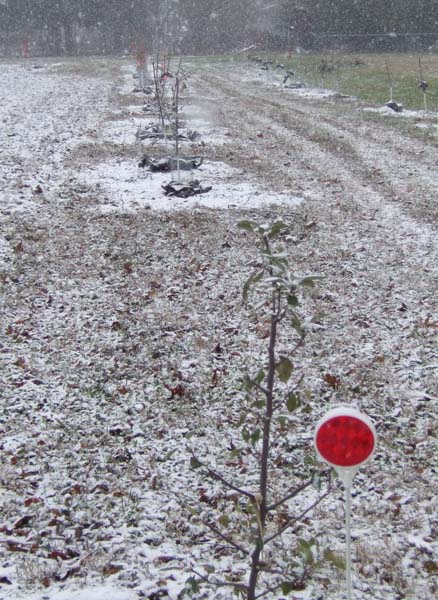Monday, June 21, 2010
planting
Monday, March 2, 2009
Snow'd 'nuf yet?
Then the dogs head toward the door and wait for me to open it. I pass the dogs and open the door. Mac gets to the threshold looks at the snow which is just deep enough under the overhang so the bottom of the storm door scrapes against it. Mac sticks his nose a bit further out, snifs a couple times and retreats, circling around to his sitting position by the cupboard as if he is waiting for a treat when he's just returned from outside. Sorry Mac No Biscuit. We all retreat to the warmth of the house, the dogs curl up on the couch and bed, I go off to take a shower.
Radar seems to indicate a couple hour gap in the storm after a bit. When it lets up I'll shovel the porch and fire up the Cub Cadet to clear the snow.
Saturday, February 14, 2009
Thursday, February 12, 2009
Saturday, January 17, 2009
Honda Insight: The tale of the fair weather Hybrid
Now the Honda hybrid design of the Insight, doesn't really operate very well as a car when the hybrid bits go on strike. The petrol engine continues to run, but there isn't enough juice available in the charging system or in the battery to really start the car repeatedly and recover from short trips. This leaves you with all these lights on the dash board flickering on and off as your driving down the road. You sort of have a choice of which ONE electrical accessory you want to use, headlamps, the radio, or the heater -- you don't have a choice with the Electric Power Steering assist, it operates at low speed sucking the remaining life out of you anemic 12V battery system. So at this point the electrical system warming lamp is coming and going, along with the BRAKE lamp, while the IMA lamp is on steady. Not quite the blue-screen-of-death, but pretty darned close, call it 'LIMP HOME' mode.
What is a hybrid less the electric bits? Junk
Two years and 24,000 miles ago, it was not looking well for the car, I figured it was out of warranty and brought it to a local mechanic, where they discovered that Honda had increased the warranty to 150,000 miles for portions of the hybrid's electric components. So off to the dealer. The dealer knew part of it was covered, but it looked like when that covered component failed, it allowed the batteries to be over drawn and trashed the remainder of the power subsystem tucked above the rear axle. Fortunately, Honda decided to cover it and replaced the entire unit. The dealer said the charge back for the repair was $6500. to Honda (at their discounted warranty labour rate.) The cost of that repair was pretty much equal to the value of the vehicle.
Fast Forward to Friday Morning: Deja Vu
Friday, January 16, 2009
Design Temperature Difference
Normally one doesn't give a lot of thought to walking over to the thermostat and spinning the dial to change the temperature, but hopefully, someone long before figured out how much heat would need to be available to satisfy that request - even when it is something like 14 below 0F outside. The difference between the coldest outside temperature and warmest inside temperature for a heating system is then something like 80F - from -14F to 66F. That 80 degrees is called the Design Temperature Difference (DTD.) Through the end of the summer, while the orchard was soaking up sun and water, yours truely was giving a lot of thought to the DTD not to mention everything else about the heating system, as after Labour Day everything between the thermostat and cast iron radiators was removed from the house as the post-war (WWII) oil-fired boiler and possibly older iron pipe, was upgraded to a modern Natural Gas-fired boiler and controls. Somewhere in there were calculations about how much heat was put out by the old system (given the size of the cast iron radiators and operating temperature), the probable heat lost of the mostly under or un-insulated house, as well as the potential heat dissipation of all the fixtures (existing and proposed.) Now that thinking's been done, in that early morning haze I wake up to a slightly warmer house thanks to the programmable thermostat, all I need do is find my slippers and can wander off to let the dogs out and then can wander into a bathroom which is 10 degrees warmer than the rest of the house, thanks to these wonderful little devices called thermostatic regulating valves.
